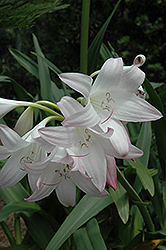It's all about ...
plants

Height: 3 feet
Spread: 3 feet
Sunlight:
![]()
![]()
Hardiness Zone: (annual)
Other Names: Crinum Jagus Lily
Description:
Blooms of white with soft pink streaks tower over dark green blades of foliage; great visual impact when massed in the garden or along borders; does very well in containers and can be overwintered indoors
Ornamental Features
St. Christopher Lily features showy white trumpet-shaped flowers with pink streaks rising above the foliage from early to mid summer. Its large sword-like leaves remain green in colour throughout the season.
Landscape Attributes
St. Christopher Lily is an herbaceous annual with tall flower stalks held atop a low mound of foliage. Its medium texture blends into the garden, but can always be balanced by a couple of finer or coarser plants for an effective composition.
This is a relatively low maintenance plant, and should be cut back in late fall in preparation for winter. It is a good choice for attracting bees and butterflies to your yard. It has no significant negative characteristics.
St. Christopher Lily is recommended for the following landscape applications;
- Accent
- General Garden Use
- Container Planting
Planting & Growing
St. Christopher Lily will grow to be about 30 inches tall at maturity, with a spread of 3 feet. Its foliage tends to remain dense right to the ground, not requiring facer plants in front. Although it's not a true annual, this fast-growing plant can be expected to behave as an annual in our climate if left outdoors over the winter, usually needing replacement the following year. As such, gardeners should take into consideration that it will perform differently than it would in its native habitat.
This plant does best in full sun to partial shade. It does best in average to evenly moist conditions, but will not tolerate standing water. It is not particular as to soil pH, but grows best in rich soils. It is somewhat tolerant of urban pollution. This species is not originally from North America. It can be propagated by multiplication of the underground bulbs.
St. Christopher Lily is a fine choice for the garden, but it is also a good selection for planting in outdoor pots and containers. With its upright habit of growth, it is best suited for use as a 'thriller' in the 'spiller-thriller-filler' container combination; plant it near the center of the pot, surrounded by smaller plants and those that spill over the edges. It is even sizeable enough that it can be grown alone in a suitable container. Note that when growing plants in outdoor containers and baskets, they may require more frequent waterings than they would in the yard or garden.

